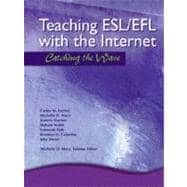
Carine M. Feyten holds bachelor's and master's degrees in Germanic philology from the University of Louvain, Belgium, her home country. She is fluent in five languages and received her Ph.D. in interdisciplinary education. She is chair of the Department of Secondary Education at the University of South Florida, directs the Foreign Language Teacher Preparation Program, and codirects a Ph.D. program in second-language acquisition and instructional technology. She directs the Suncoast Alliance of Florida in Foreign Language and Literatures, was president of the Florida Foreign Language Association, and is currently second vice president of the National Network on Early Language Learning. She has won several teaching awards and one research award, has presented nationally and internationally, and has published in such journals as the Modern Language Journal, The Middle School Journal and Language Quarterly.
Michelle D. Macy holds bachelor's and master's degrees in French language and literature. She is currently a visiting faculty member in the Department of Secondary Education at the University of South Florida, where she conducts courses associated with the Florida ESOL infusion program for preservice teachers, as well as internship supervision. She is presently completing a Ph.D. in second-language acquisition and instructional technology. She has taught both on-campus and overseas courses in French language and culture/civilization, and ESL/EFL. Her interests lie in SLA/instructional technology, ESOL, and teacher preparation.
Jeannie Ducher completed her D.E.U.G. and Maitrise degrees in France in English language and civilization, and English literary translation, respectively. She is currently completing a Ph.D. in second-language acquisition and instructional technology at the University of South Florida. She has taught French language courses for the Division of Languages and Linguistics and currently teaches education courses for secondary education. She has also supervised preservice teachers during their field experiences. Her interests are in teacher education, SLA and technology and assessment using computer adaptive testing.
Makoto Yoshii recently received his Ph.D. in second-language acquisition and instructional technology at the University of South Florida in Tampa, Florida. He holds a bachelor's degree in English literature from Kagoshima University in Japan, masters degrees in religious education and in divinity from Cincinnati Bible Seminary in Ohio, and a master's degree in applied linguistics from Indiana University. He is currently teaching EFL at Baiko Jo Gakuin College in Shimonoseki, Japan. He has taught both Japanese and ESL in the United States. His interests lie in CALL (computer-assisted language learning), particularly in the use of glosses in multimedia reading programs.
Eunwook Park is pursuing a Ph.D. in second-language acquisition and instructional technology at the University of South Florida. He holds a bachelor's in French language and literature, with a minor in education, and a master's in French linguistics. He is a certified teacher of French in Korea, and has worked for various government organizations, as well as in the field of international business as a translator /interpreter. He has been working as a teaching assistant for the Florida ESOL infusion program for preservice teachers, using various recent technologies, such as video conferencing and Internet courseware. He is interested in wide range of CALL subjects, especially in teaching languages using the Internet for classroom or distance learning.
Brendan Calandra is a Ph.D. student in instructional technology with a cognate in second-language acquisition at the University of South Florida. He has a masters degree from the University of Florida in German literature. Brendan currently works as a consultant for the Florida Center for Instructional Technology and teaches German for the Division of Languages and Linguistics at USF. He has been teaching modern languages at home and abroad since 1992.
John Meros is a foreign language curriculum writer for the Melrose Center for Communications and Mass Media and a doctoral student at the University of South Florida in second-language acquisition and instructional technology. He has taught foreign language and ESOL for more than 17 years at various levels, cocreated the Pinellas district's acclaimed FLES (Elementary Foreign Language) program, and is now helping create the Melrose curriculum as he enters the Ph.D. candidate phase of his studies.
(NOTE: Each chapter begins with A Rational & Guide for Integrating Listening into English Language Instruction. Chapters include two Beginning Lessons, Intermediate Lessons, and Advanced Lessons.)
1. Good Vibrations: Improving Listening Skills.
The New copy of this book will include any supplemental materials advertised. Please check the title of the book to determine if it should include any access cards, study guides, lab manuals, CDs, etc.
The Used, Rental and eBook copies of this book are not guaranteed to include any supplemental materials. Typically, only the book itself is included. This is true even if the title states it includes any access cards, study guides, lab manuals, CDs, etc.